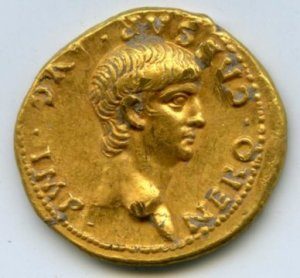
The discovery of a rare gold coin bearing the image of the Roman Emperor Nero at the University of North Carolina at Charlotte’s archaeological excavations on Mount Zion in Jerusalem, has just been announced by the archaeologists in charge of the project, Drs. Shimon Gibson, James Tabor, and Rafael Lewis.
“The coin is exceptional,” said Gibson, “because this is the first time that a coin of this kind has turned up in Jerusalem in a scientific dig. Coins of this type are usually only found in private collections, where we don’t have clear evidence as to place of origin.”
The gold coin (aureus) bears the bare-headed portrait of the young Nero as Caesar. The lettering around the edge of the coin reads: NERO CAESAR AVG IMP. On the reverse of the coin is a depiction of an oak wreath containing the letters “EX S C,” with the surrounding inscription “PONTIF MAX TR P III.” Importantly, these inscriptions help to work out the date when the coin was struck as 56/57 AD. Identification of the coin was made by the historian and numismatist, Dr. David Jacobson from London.
The coin dates to a little more than a decade before the destruction of Jerusalem by the Romans in 70 AD, and was found in rubble material outside the ruins of the 1st Century Jewish villas the team has been excavating. The team has hypothesized that the large houses may have belonged to wealthy members of the priestly caste, and it may have come from one of their stores of wealth.
“The coin probably came from one of the rich 2000-year old Jewish dwellings which the UNC Charlotte team have been uncovering at the site,” said Gibson. “These belonged to the priestly and aristocratic quarter located in the Upper City of Jerusalem. Finds include the well-preserved rooms of a very large mansion, a Jewish ritual pool (mikveh) and a bathroom, both with their ceilings intact.”
This mansion and other like it, were utterly destroyed by Titus and the Roman legions, when Jerusalem was razed to the ground. It is likely, owing to the intrinsic value of the gold coin, it was hidden away ahead of the destruction of the city, and was missed by the marauding and looting Roman soldiers.
“It’s a valuable piece of personal property and wouldn’t have been cast away like rubbish or casually dropped. It’s conceivable that it ended up outside these structures in the chaos that happened as this area was destroyed.”
The image of Nero is significant in that it shows the presence of the Roman occupation and provides a clear late date for the occupation of the residences. There is no historical evidence that Nero ever visited Jerusalem. Tabor pointed out that the coin is dated “to the same year of St. Paul’s last visit to Jerusalem, which resulted in his arrest (on the charge of taking Gentiles into the Temple) and incarceration in Caesarea.” Last of the Julio-Claudian line, Nero was Roman emperor for fourteen years (54-68 AD). He had the reputation for being a tyrant, and some believed he was responsible for the devastating fire of 64 AD, which resulted in the burning of much of Rome.
The archaeological project has brought to light many other significant finds during the 2016 summer season, and work at the site will be resumed next year.
Source: News release of the University of North Carolina, Charlotte.
______________________________________
Popular Archaeology will be co-hosting a March, 2017 study tour of Holy Land sites. Locations will include archaeological sites from Tel Dan in the north to Biblical Tamar in the desert south of the Dead Sea, and will include such places as the iconic sites in and around the Sea of Galilee and Jerusalem, Qumran (near the Dead Sea scroll caves), Masada, and an optional stay inside Jerusalem’s Old City walls for an up-close-and-personal experience of the ambience within the Old City. A tour of the Mount Zion dig site, where the Roman coin was found, will also be included in the tour. More information about this opportunity can be obtained at the tour page.
___________________________________________________________

______________________________________________
Travel and learn with Far Horizons.
____________________________________________
This richly illustrated issue includes the following stories: Recent findings shedding new light on the whereabouts of the remains of Philip of Macedon, father of Alexander the Great; how an archaeologist-sculptor is bringing bones of the dead back to life; archaeologists uncovering town life at the dawn of civilization; an exclusive interview with internationally acclaimed archaeologist James M. Adovasio about what makes the Meadowcroft Rockshelter prominent in the ongoing search for the first Americans; what archaeologists are finding at the site of the ancient city of Gath, the home town of the biblical Philistine giant, Goliath; and how scientists are redrawing the picture of human evolution in Europe. Find it on Amazon.com.







